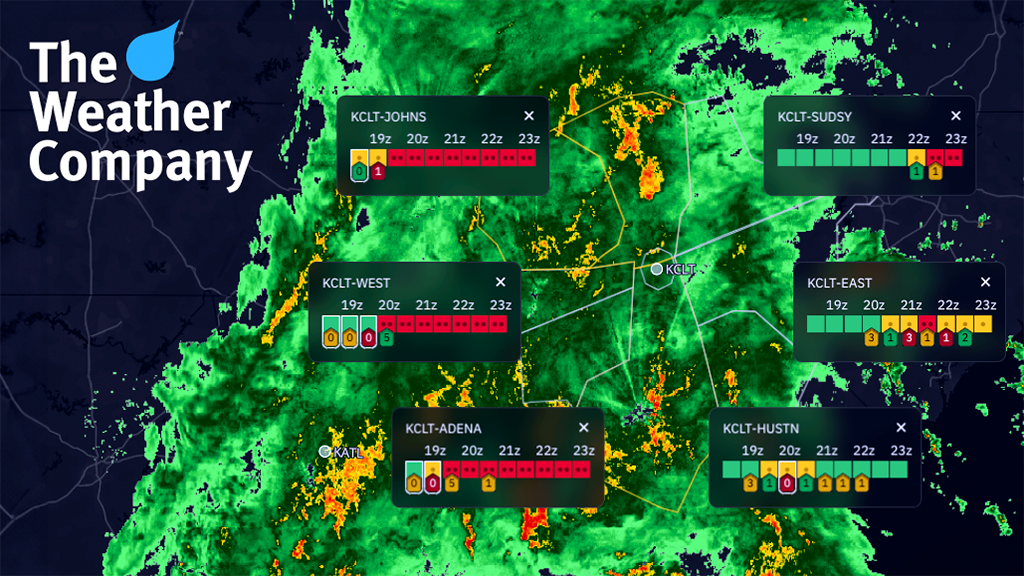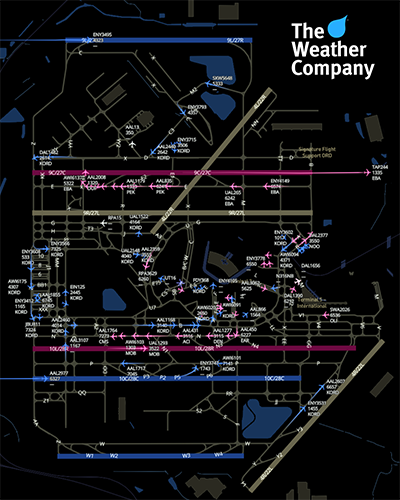Advanced Weather Forecasting for Terminal Ops: Plan More, React Less

For air traffic managers, the terminal area is critical for aircraft transition between en route flight paths and their final approach or departure. It's also one of the most challenging zones to manage—especially in the face of severe weather. Weather disruption is the leading cause of air traffic delays in the U.S., and the second-leading cause in Europe1.
For more than 30 years, The Weather Company has empowered aviation professionals to make informed confident decisions in the face of severe weather. Thunderstorms, low visibility, turbulence—these are just a few of the elements that can bring operations to a standstill. Convective storms, in particular, can lead to ground stops, as dangerous conditions such as lightning, turbulence, and updrafts force aircraft into holding patterns.
To help the aviation industry mitigate weather's uncertainty, The Weather Company introduced Terminal Airspace Convection Risk (TrACR). This solution:
- Provides convective forecasts in 30-minute intervals, looking up to seven hours ahead.
- Simplifies processes with clear visual representations of forecast changes, allowing dispatchers and pilots to quickly adjust flight plans based on real-time insights.
- Is now offered in 26 U.S. airports, with plans to roll out globally later this year, extending coverage to 15 major airports in Europe and Asia.
In addition to convective storms, aviation professionals face fog, snow, and rain, which can create low ceilings and poor visibility, leading to further delays. These conditions force greater separation between aircraft, reducing the number of flights airports can safely manage. As visibility worsens, the Airport Acceptance Rate (AAR) drops, leading to delays, diversions, or cancellations.
The Weather Company's latest ceiling and visibility updates provide an enhanced, data-driven approach to these problems. With a 20% improvement in the equitable threat score at critical visibility thresholds across North America, users can count on significant enhancements to forecast accuracy.
Combined with conditional probability forecasts for precipitation, operations teams are equipped with the information they need to anticipate and mitigate delays, avoid costly diversions, and keep flights on schedule.
Terminal area congestion doesn't stop there. Wind shear, crosswinds, and runway saturation can overwhelm the system, creating gridlock in the air and on the ground. Aircraft in holding patterns burn more fuel, and extended taxi times lead to crew duty overruns and disrupted passenger connections.

The Weather Company's new airport capacity insights provide operations teams with up to 12 hours of forecasted capacity constraints, allowing them to proactively manage ground delays and minimize airborne holding. Additionally, The Weather Company's Global Surface Movement (GSM) tool allows airlines to monitor real-time ground traffic conditions and collaborate with Air Traffic Control (ATC) to adjust departure schedules and reduce fuel consumption, ultimately enhancing passenger comfort.
As airlines struggle with increasingly adverse weather events in terminal areas, TrACR offers game-changing support. By delivering real-time, actionable forecasts for convective weather in critical arrival and departure corridors, TrACR enables airlines to stay ahead of weather-induced disruptions.
It's not just about reacting to storms—it's about planning for them. With TrACR, operations teams can minimize delays, conserve fuel, and protect their bottom line. As it expands to airports worldwide, TrACR will continue to be a critical decision support tool, helping the industry navigate the skies more efficiently and safely.
Learn more about advanced Weather Forecast Services.




